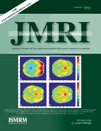Robust mapping of the myelin water fraction in the presence of noise: Synergic combination of anisotropic diffusion filter and spatially regularized nonnegative least squares algorithm
Abstract
Purpose:
To improve the mapping of myelin water fraction (MWF) despite the presence of measurement noise, and to increase the visibility of fine structures in MWF maps.
Materials and Methods:
An anisotropic diffusion filter (ADF) was effectively combined with a spatially regularized nonnegative least squares algorithm (srNNLS) for robust MWF mapping. Synthetic data simulations were performed to assess the effectiveness of this new method. Experimental measurements of signal decay curves were obtained and MWF maps were estimated using the new method and compared with maps estimated using other methods.
Results:
MWF mapping was substantially improved in both simulations and experimental data when ADF was combined with the srNNLS algorithm. MWF variability decreased with the use of the proposed method, which in turn resulted in increased visibility of small focal lesions and structures in the MWF maps.
Conclusion:
This study demonstrates that the benefits of ADF and srNNLS algorithms can be effectively combined in a synergic way for robust mapping of MWF in the presence of noise. Substantial improvements to MWF mapping can be made using the proposed method. J. Magn. Reson. Imaging 2011;. © 2011 Wiley-Liss, Inc.




